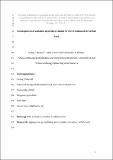Files in this item
Consequences of variation in predator attack for the evolution of the selfish herd
Item metadata
| dc.contributor.author | Morrell, L.J. | |
| dc.contributor.author | Greenwood, L. | |
| dc.contributor.author | Ruxton, G.D. | |
| dc.date.accessioned | 2015-11-19T11:40:02Z | |
| dc.date.available | 2015-11-19T11:40:02Z | |
| dc.date.issued | 2015-01 | |
| dc.identifier | 158740070 | |
| dc.identifier | 2e5d8d3e-4687-4c42-904d-24b499a35c84 | |
| dc.identifier | 000347528300007 | |
| dc.identifier | 84922074766 | |
| dc.identifier.citation | Morrell , L J , Greenwood , L & Ruxton , G D 2015 , ' Consequences of variation in predator attack for the evolution of the selfish herd ' , Evolutionary Ecology , vol. 29 , no. 1 , pp. 107-121 . https://doi.org/10.1007/s10682-014-9743-6 | en |
| dc.identifier.issn | 0269-7653 | |
| dc.identifier.other | ORCID: /0000-0001-8943-6609/work/60427468 | |
| dc.identifier.uri | https://hdl.handle.net/10023/7821 | |
| dc.description.abstract | There is a strong body of evidence that patterns of collective behaviour in grouping animals are governed by interactions between small numbers of individuals within the group. These findings contrast with study of the ‘selfish herd’, where increasingly complex individual-level movement rules have been proposed to explain the rapid increase in aggregation observed when prey groups are startled by or detect a predator. While individuals using simple rules take into account the position of only a few neighbours, those using complex rules incorporate multiple neighbours, and their relative distance, to determine their movement direction. Here, we simulate the evolution of selfish herd behaviour to assess the conditions under which simple and complex movement rules might evolve, explicitly testing predictions arising from previous work. We find that complex rules outperform simple ones under a range of predator attack strategies, but that simple rules can fix in populations particularly when they are already in the majority, suggesting strong positive frequency dependence in rule success. In addition, we explore whether a movement rule derived from studies of collective behaviour (where individuals use the position of seven neighbours to determine movement direction) performs as successfully as more complex rules, finding again positive frequency dependence in rule success, and a particular role for predator attack strategy (from within or outside the group). | |
| dc.format.extent | 394641 | |
| dc.language.iso | eng | |
| dc.relation.ispartof | Evolutionary Ecology | en |
| dc.subject | Aggregation | en |
| dc.subject | Group living | en |
| dc.subject | Anti-predator behaviour | en |
| dc.subject | Selfish herd | en |
| dc.subject | QH301 Biology | en |
| dc.subject | QL Zoology | en |
| dc.subject | 3rd-NDAS | en |
| dc.subject.lcc | QH301 | en |
| dc.subject.lcc | QL | en |
| dc.title | Consequences of variation in predator attack for the evolution of the selfish herd | en |
| dc.type | Journal article | en |
| dc.contributor.institution | University of St Andrews. School of Biology | en |
| dc.contributor.institution | University of St Andrews. Centre for Biological Diversity | en |
| dc.identifier.doi | 10.1007/s10682-014-9743-6 | |
| dc.description.status | Peer reviewed | en |
This item appears in the following Collection(s)
Items in the St Andrews Research Repository are protected by copyright, with all rights reserved, unless otherwise indicated.

